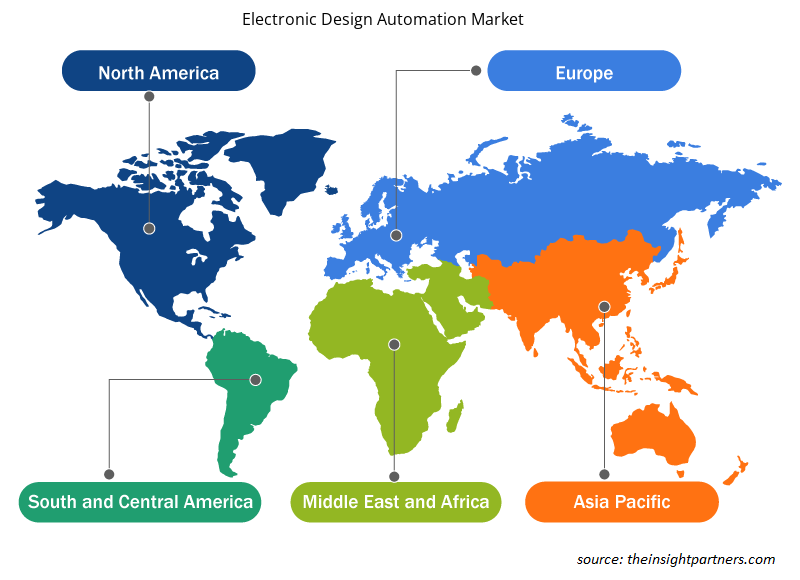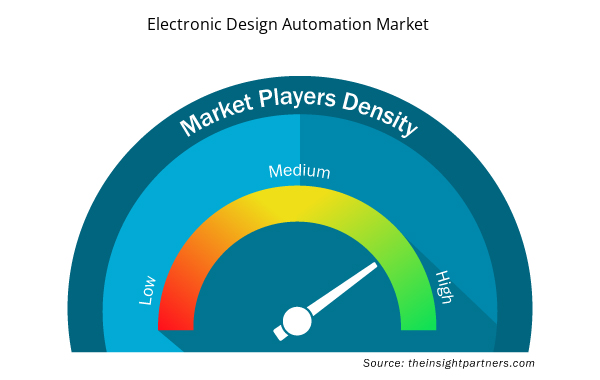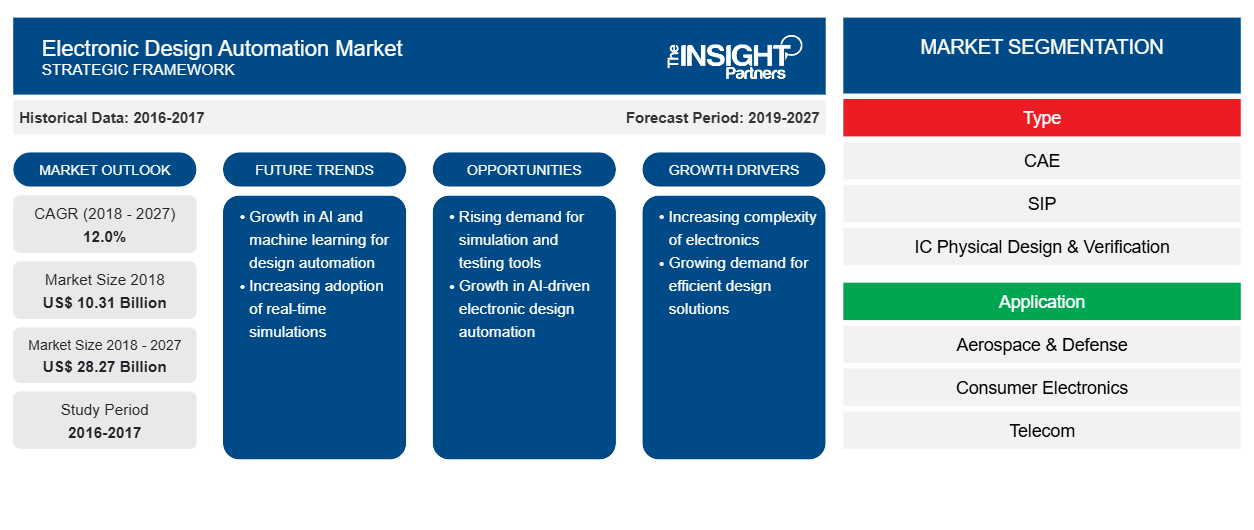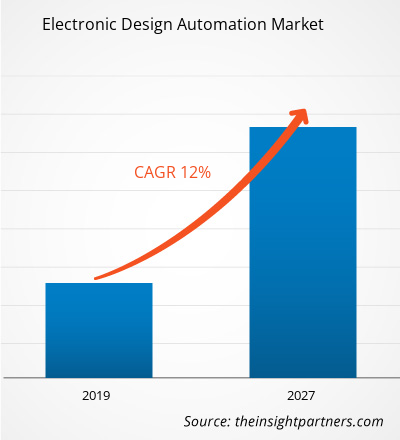Der Markt für elektronische Designautomatisierung belief sich im Jahr 2018 auf 10,31 Milliarden US-Dollar und dürfte im Prognosezeitraum 2019–2027 mit einer durchschnittlichen jährlichen Wachstumsrate von 12,0 % wachsen und bis 2027 einen Wert von 28,27 Milliarden US-Dollar erreichen.
Software zur Automatisierung des elektronischen Designs umfasst mehrere Tools und Anwendungen. Die Integration dieser Tools entsprechend den Kundenanforderungen kann manchmal eine komplizierte Aufgabe sein. Die komplexen Anforderungen der Endbenutzer hinsichtlich einer äußerst stabilen und genauen Produktpositionierung werden mithilfe von EDA erfüllt. Die steigende Komplexität und die Kostenherausforderungen, mit denen die Industrie bei der Implementierung teurer, komplexer Designs konfrontiert ist, sind die Hauptfaktoren, die die Nachfrage nach EDA antreiben.
Es wird erwartet, dass die Region Asien-Pazifik die dominierende Region auf dem Markt für elektronische Designautomatisierung sein wird. Der Hauptgrund dafür ist das riesige Elektronik- und Halbleiterzentrum in China in Verbindung mit der hohen Bevölkerungsdichte der Region. Außerdem wird China weltweit am meisten Halbleiter liefern. Die neuen Marktinitiativen und strategischen Partnerschaften werden im Prognosezeitraum voraussichtlich fortgesetzt und tragen zu einem starken Wachstum des Marktes für elektronische Designautomatisierung in der Region bei.
Passen Sie diesen Bericht Ihren Anforderungen an
Sie erhalten kostenlos individuelle Anpassungen an jedem Bericht, einschließlich Teilen dieses Berichts oder einer Analyse auf Länderebene, eines Excel-Datenpakets sowie tolle Angebote und Rabatte für Start-ups und Universitäten.
- Holen Sie sich die wichtigsten Markttrends aus diesem Bericht.Dieses KOSTENLOSE Beispiel umfasst eine Datenanalyse von Markttrends bis hin zu Schätzungen und Prognosen.
Wachstum der Halbleiterindustrie
Die SIA (Semiconductor Industry Association) verzeichnete im Oktober 2018, als sie das führende US-Unternehmen in der Halbleiterforschung, -entwicklung und -herstellung vertrat, einen Anstieg von 12,7 % gegenüber 2017 und gab einen Gesamtumsatz von 41,8 Milliarden US-Dollar an. Darüber hinaus prognostizierte die WSTS eine Entwicklung von 15,9 % im Jahr 2018 und 2,6 % im Jahr 2019. Dieses Wachstum in der Halbleiterindustrie hat das Vertrauen der Akteure auf dem Markt für elektronische Designautomatisierung in Bezug auf das Umsatzwachstum gestärkt. Die in der Halbleiterlandschaft tätigen Unternehmen erwarten nicht nur eine erhebliche Umsatzsteigerung, sondern steigern auch entsprechend ihre F&E-Ausgaben. Der Anstieg der F&E-Ausgaben gegenüber dem Vorjahr hat dem Markt für elektronische Designautomatisierung in der jüngsten Vergangenheit einen bemerkenswerten Schub verliehen und wird den Markt Prognosen zufolge auch in den kommenden Jahren antreiben.
Da sich die Halbleiterindustrie weiterhin in einem starken Aufschwung befindet, wird erwartet, dass die Marktführer im Bereich der elektronischen Designautomatisierung einen zukunftsorientierten Ansatz verfolgen, indem sie unkonventionelle Endmärkte wie künstliche Intelligenz, autonome Fahrzeuge und IoT in Betracht ziehen. Darüber hinaus werden die Speicherunternehmen wahrscheinlich auch einen Umsatzanstieg verzeichnen, da die Nachfrage nach Rechenzentrums-Smartphones und autonomen Fahrzeugtechnologien steigt. Die Konvergenz unzähliger Halbleiter-Endverbrauchermärkte hat zu einer erheblichen Expansion der Branche geführt, die wiederum den Markt für elektronische Designautomatisierung für Technologie, Software und Automatisierung vorangetrieben hat.
Steigende Verbreitung von IoT, künstlicher Intelligenz und virtueller Realität
Smart Homes, Fernseher, Smartphones, Internet der Dinge, vernetzte Autos, künstliche Intelligenz – all diese Aspekte des menschlichen Lebens sind von der Unterhaltungselektronikindustrie durchdrungen. Die weltweite Nachfrage nach Unterhaltungselektronik wird weitgehend durch den Wunsch der Verbraucher nach größeren, neueren und verbesserten Funktionen angetrieben, was den Sektor wiederum dazu ermutigt hat, ständig Innovationen und Technologien zu erforschen, die nicht nur die Vorstellungskraft der Menschen anregen, sondern auch erschwinglich und relevant sind, um ihre täglichen Bedürfnisse zu erfüllen. In solchen Fällen unterstützen die EDA-Softwareanbieter die Hersteller elektronischer Komponenten und Techniker bei der Entwicklung geeigneter Prototypen der Geräte. Daher wird erwartet, dass die sich entwickelnden Erwartungen der Verbraucher und die wachsende Nachfrage nach Unterhaltungselektronik den EDA-Markt in den kommenden Jahren antreiben werden.
Nachfolgend sind einige der jüngsten Strategien einiger Akteure auf dem Markt für elektronische Designautomatisierung aufgeführt:
2018: Cadence Design Systems, Inc. gab eine strategische Partnerschaft mit Green Hills Software bekannt, um die Sicherheit und den Schutz eingebetteter Geräte zu beschleunigen. Cadence Design Systems, Inc. investierte 150 Millionen US-Dollar, was etwa 16 % der Eigentumsanteile an GreenHill entspricht.
2018: Keysight Technologies wurde von ON Semiconductor als EDA-Partner ausgewählt, um eine Designlösung für Leistungsgeräte bereitzustellen, die die Zuverlässigkeit erhöhen und die Markteinführungszeit verkürzen soll.
2018: Synopsys, Inc. und Siemens AG gaben eine Zusammenarbeit für eine breite Palette von EDA-Projekten bekannt. Darüber hinaus haben Siemens und Synopsys alle noch ausstehenden Patentstreitigkeiten zwischen Synopsys und Mentor Graphics beigelegt.
Der Bericht segmentiert den globalen Markt für elektronische Designautomatisierung wie folgt:
Regionale Einblicke in den Markt für elektronische Designautomatisierung
Die regionalen Trends und Faktoren, die den Markt für Electronic Design Automation im Prognosezeitraum beeinflussen, wurden von den Analysten von Insight Partners ausführlich erläutert. In diesem Abschnitt werden auch die Marktsegmente und die Geografie von Electronic Design Automation in Nordamerika, Europa, im asiatisch-pazifischen Raum, im Nahen Osten und Afrika sowie in Süd- und Mittelamerika erörtert.

- Erhalten Sie regionale Daten zum Markt für elektronische Designautomatisierung
Umfang des Marktberichts zur elektronischen Designautomatisierung
| Berichtsattribut | Details |
|---|---|
| Marktgröße im Jahr 2018 | 10,31 Milliarden US-Dollar |
| Marktgröße bis 2027 | 28,27 Milliarden US-Dollar |
| Globale CAGR (2018 - 2027) | 12,0 % |
| Historische Daten | 2016-2017 |
| Prognosezeitraum | 2019–2027 |
| Abgedeckte Segmente | Nach Typ
|
| Abgedeckte Regionen und Länder | Nordamerika
|
| Marktführer und wichtige Unternehmensprofile |
|
Dichte der Marktteilnehmer für Electronic Design Automation: Die Auswirkungen auf die Geschäftsdynamik verstehen
Der Markt für Electronic Design Automation wächst rasant, angetrieben durch die steigende Nachfrage der Endnutzer aufgrund von Faktoren wie sich entwickelnden Verbraucherpräferenzen, technologischen Fortschritten und einem größeren Bewusstsein für die Vorteile des Produkts. Mit steigender Nachfrage erweitern Unternehmen ihr Angebot, entwickeln Innovationen, um die Bedürfnisse der Verbraucher zu erfüllen, und nutzen neue Trends, was das Marktwachstum weiter ankurbelt.
Die Marktteilnehmerdichte bezieht sich auf die Verteilung der Firmen oder Unternehmen, die in einem bestimmten Markt oder einer bestimmten Branche tätig sind. Sie gibt an, wie viele Wettbewerber (Marktteilnehmer) in einem bestimmten Marktraum im Verhältnis zu seiner Größe oder seinem gesamten Marktwert präsent sind.
Die wichtigsten Unternehmen auf dem Markt für elektronische Designautomatisierung sind:
- Agnisys Inc.
- Aldec, Inc.
- Autodesk, Inc.
- Cadence Design Systems, Inc.
- Labcenter Electronics Ltd.
Haftungsausschluss : Die oben aufgeführten Unternehmen sind nicht in einer bestimmten Reihenfolge aufgeführt.

- Überblick über die wichtigsten Akteure auf dem Markt für Electronic Design Automation
Globaler Markt für elektronische Designautomatisierung – nach Typ
- Computergestützte Entwicklung (CAE)
- Halbleiter-IP (SIP)
- Physikalischer IC-Entwurf und Verifizierung
- Leiterplatte (PCB) und Multi-Chip-Modul (MCM)
Globaler Markt für elektronische Designautomatisierung – nach Anwendung
- Luft- und Raumfahrt & Verteidigung
- Unterhaltungselektronik
- Telekommunikation
- Automobilindustrie
- Industrie
- Sonstiges
Globaler Markt für elektronische Designautomatisierung – nach Geografie
- Nordamerika
- UNS
- Kanada
- Mexiko
- Europa
- Frankreich
- Deutschland
- Italien
- Spanien
- Vereinigtes Königreich
- Restliches Europa
- Asien-Pazifik (APAC)
- China
- Indien
- Japan
- Südkorea
- Restlicher Asien-Pazifik-Raum
- Rest der Welt (RoW)
- Südamerika
- Naher Osten und Afrika
Globaler Markt für Electronic Design Automation – Unternehmensprofile
- Agnisys Inc.
- Aldec, Inc.
- Autodesk, Inc.
- Cadence Design Systems, Inc.
- Labcenter Electronics Ltd.
- Keysight Technologies
- Mentor Graphics Corporation
- Silvaco, Inc.
- Synopsys, Inc.
- Zuken Inc.
- Historische Analyse (2 Jahre), Basisjahr, Prognose (7 Jahre) mit CAGR
- PEST- und SWOT-Analyse
- Marktgröße Wert/Volumen – Global, Regional, Land
- Branche und Wettbewerbsumfeld
- Excel-Datensatz



Report Coverage
Revenue forecast, Company Analysis, Industry landscape, Growth factors, and Trends

Segment Covered
This text is related
to segments covered.

Regional Scope
North America, Europe, Asia Pacific, Middle East & Africa, South & Central America

Country Scope
This text is related
to country scope.
Trends and growth analysis reports related to Technology, Media and Telecommunications : READ MORE..
The List of Companies
- Agnisys Inc.
- Aldec, Inc.
- Autodesk, Inc.
- Cadence Design Systems, Inc.
- Labcenter Electronics Ltd.
- Keysight Technologies
- Mentor Graphics Corporation
- Silvaco, Inc.
- Synopsys, Inc.
- Zuken Inc.
The Insight Partners performs research in 4 major stages: Data Collection & Secondary Research, Primary Research, Data Analysis and Data Triangulation & Final Review.
- Data Collection and Secondary Research:
As a market research and consulting firm operating from a decade, we have published and advised several client across the globe. First step for any study will start with an assessment of currently available data and insights from existing reports. Further, historical and current market information is collected from Investor Presentations, Annual Reports, SEC Filings, etc., and other information related to company’s performance and market positioning are gathered from Paid Databases (Factiva, Hoovers, and Reuters) and various other publications available in public domain.
Several associations trade associates, technical forums, institutes, societies and organization are accessed to gain technical as well as market related insights through their publications such as research papers, blogs and press releases related to the studies are referred to get cues about the market. Further, white papers, journals, magazines, and other news articles published in last 3 years are scrutinized and analyzed to understand the current market trends.
- Primary Research:
The primarily interview analysis comprise of data obtained from industry participants interview and answers to survey questions gathered by in-house primary team.
For primary research, interviews are conducted with industry experts/CEOs/Marketing Managers/VPs/Subject Matter Experts from both demand and supply side to get a 360-degree view of the market. The primary team conducts several interviews based on the complexity of the markets to understand the various market trends and dynamics which makes research more credible and precise.
A typical research interview fulfils the following functions:
- Provides first-hand information on the market size, market trends, growth trends, competitive landscape, and outlook
- Validates and strengthens in-house secondary research findings
- Develops the analysis team’s expertise and market understanding
Primary research involves email interactions and telephone interviews for each market, category, segment, and sub-segment across geographies. The participants who typically take part in such a process include, but are not limited to:
- Industry participants: VPs, business development managers, market intelligence managers and national sales managers
- Outside experts: Valuation experts, research analysts and key opinion leaders specializing in the electronics and semiconductor industry.
Below is the breakup of our primary respondents by company, designation, and region:

Once we receive the confirmation from primary research sources or primary respondents, we finalize the base year market estimation and forecast the data as per the macroeconomic and microeconomic factors assessed during data collection.
- Data Analysis:
Once data is validated through both secondary as well as primary respondents, we finalize the market estimations by hypothesis formulation and factor analysis at regional and country level.
- Macro-Economic Factor Analysis:
We analyse macroeconomic indicators such the gross domestic product (GDP), increase in the demand for goods and services across industries, technological advancement, regional economic growth, governmental policies, the influence of COVID-19, PEST analysis, and other aspects. This analysis aids in setting benchmarks for various nations/regions and approximating market splits. Additionally, the general trend of the aforementioned components aid in determining the market's development possibilities.
- Country Level Data:
Various factors that are especially aligned to the country are taken into account to determine the market size for a certain area and country, including the presence of vendors, such as headquarters and offices, the country's GDP, demand patterns, and industry growth. To comprehend the market dynamics for the nation, a number of growth variables, inhibitors, application areas, and current market trends are researched. The aforementioned elements aid in determining the country's overall market's growth potential.
- Company Profile:
The “Table of Contents” is formulated by listing and analyzing more than 25 - 30 companies operating in the market ecosystem across geographies. However, we profile only 10 companies as a standard practice in our syndicate reports. These 10 companies comprise leading, emerging, and regional players. Nonetheless, our analysis is not restricted to the 10 listed companies, we also analyze other companies present in the market to develop a holistic view and understand the prevailing trends. The “Company Profiles” section in the report covers key facts, business description, products & services, financial information, SWOT analysis, and key developments. The financial information presented is extracted from the annual reports and official documents of the publicly listed companies. Upon collecting the information for the sections of respective companies, we verify them via various primary sources and then compile the data in respective company profiles. The company level information helps us in deriving the base number as well as in forecasting the market size.
- Developing Base Number:
Aggregation of sales statistics (2020-2022) and macro-economic factor, and other secondary and primary research insights are utilized to arrive at base number and related market shares for 2022. The data gaps are identified in this step and relevant market data is analyzed, collected from paid primary interviews or databases. On finalizing the base year market size, forecasts are developed on the basis of macro-economic, industry and market growth factors and company level analysis.
- Data Triangulation and Final Review:
The market findings and base year market size calculations are validated from supply as well as demand side. Demand side validations are based on macro-economic factor analysis and benchmarks for respective regions and countries. In case of supply side validations, revenues of major companies are estimated (in case not available) based on industry benchmark, approximate number of employees, product portfolio, and primary interviews revenues are gathered. Further revenue from target product/service segment is assessed to avoid overshooting of market statistics. In case of heavy deviations between supply and demand side values, all thes steps are repeated to achieve synchronization.
We follow an iterative model, wherein we share our research findings with Subject Matter Experts (SME’s) and Key Opinion Leaders (KOLs) until consensus view of the market is not formulated – this model negates any drastic deviation in the opinions of experts. Only validated and universally acceptable research findings are quoted in our reports.
We have important check points that we use to validate our research findings – which we call – data triangulation, where we validate the information, we generate from secondary sources with primary interviews and then we re-validate with our internal data bases and Subject matter experts. This comprehensive model enables us to deliver high quality, reliable data in shortest possible time.


 Holen Sie sich ein kostenloses Muster für diesen Bericht
Holen Sie sich ein kostenloses Muster für diesen Bericht